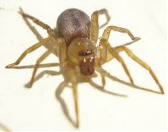Chirocanthium mildei

These spiders are about l/4 inch long, with legs and cephalothorax darker than the abdomen. It has been reported as being yellow, white, or greenish. In late summer and early fall, Yellow House spiders migrate into structures and automobiles. At this time, they have not reached the adult stage, and they weave protective, white, silken cocoon-like webs in which to overwinter and molt into the adult stage in spring. The Yellow House spider will bite if pressed or accidently confined (e.g. during the victims sleep). The venom has been described as causing pain and reddening at the site of the bite. In some instances a deadening of the tissue will occur, but much less severe than that caused by the Brown Recluse spider. Children that show symptoms of spider bites (the two fang marks) may have been bitten by the Yellow House spider. This spider, however, cannot pierce the skin of everyone; there is a very large margin of safety.
Habitat Alterations
- Close gaps around outside entry doors and ground floor windows that may be entry points for the spider.
- Keep grass low next to building foundations to discourage wandering spiders.


